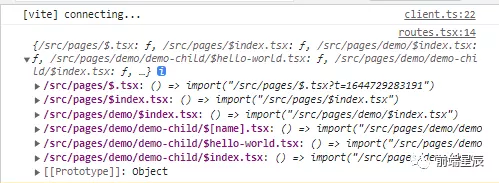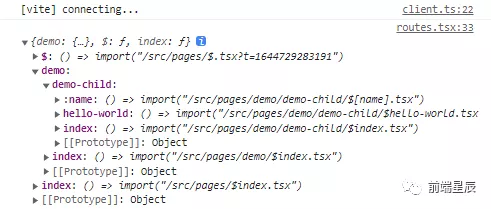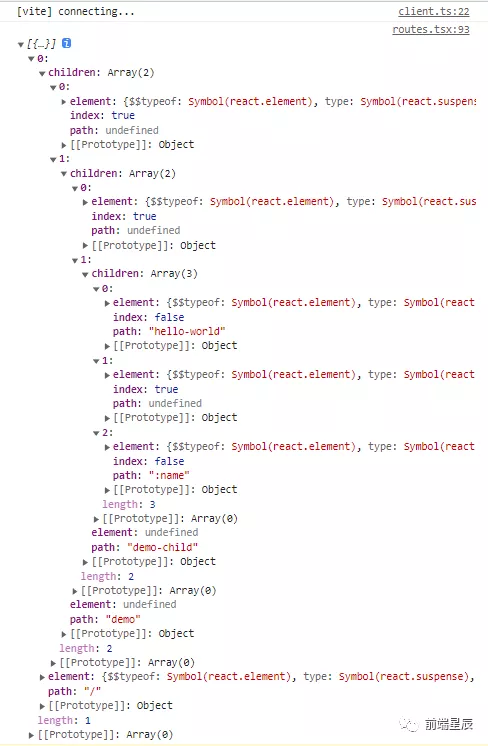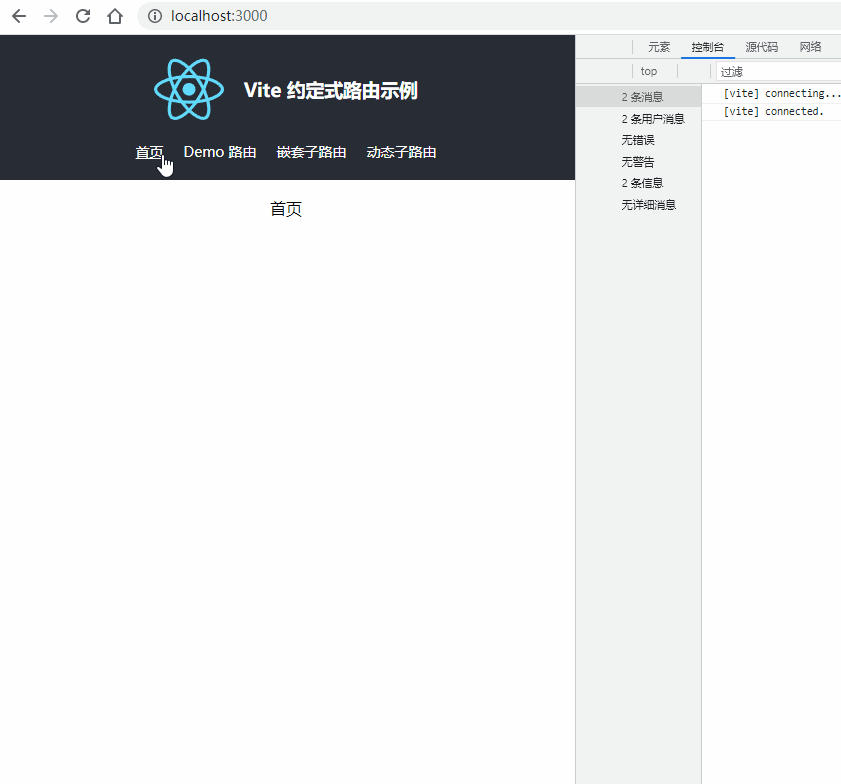当前栏目
Vite 约定式路由的优秀实践
路由Next.js 想必大家不陌生吧,其中最为熟知的就是约定式路由(基于文件系统)。现在我们来在Vite 中巧妙地实现这一项省心的功能。
本文是以 React 结合 React-Router 实现,vue的实现思路基本一致,只有后缀名和 vue-router的差别,需要的可以照搬此方案。
路由形式
首先看看 Next.js 基于文件约定式路由长什么样。Next.js将文件添加到 pages 目录时,它会自动生成对应的路由。在开发时省去了很多模板代码,提升开发效率。
特性一:它将 index 文件名 js|jsx|ts|tsx 结尾的文件,映射成当前目录的根路由:
- pages/index.js → /
- pages/blog/index.js → /blog
特性二:支持嵌套目录文件。如果创建嵌套文件夹结构,文件将自动以相同的方式生成路由:
- pages/about.js → /about
- pages/blog/first-post.js → /blog/first-post
- pages/dashboard/settings/username.js → /dashboard/settings/username
特性三:使用括号语法。匹配动态命名参数:
- pages/blog/[slug].js → /blog/:slug( /blog/hello-world)
- pages/[username]/settings.js → /:username/settings( /foo/settings)
这种路由方式看起来非常清晰,创建一个路由就如同写组件一样简单。umijs 也支持约定式路由,形式基本一致,用过的想必也因此受益。然而 Vite作为一个脚手架提供更加通用的功能以支持 vue和 react,自然不会耦合这种路由方案。
启发
在 Vite 官方文档中 https://cn.vitejs.dev/guide/features.html#glob-import Glob 导入是这样介绍的:
Vite 支持使用特殊的 import.meta.glob 函数从文件系统导入多个模块:
const modules = import.meta.glob('./dir/*.js');
以上将会被转译为下面的样子:
const modules = {
'./dir/foo.js': () => import('./dir/foo.js'),
'./dir/bar.js': () => import('./dir/bar.js'),
};
这个 API 就类似 Webpack 的require.context()。Nice. 可以来个大胆的想法,用 React.lazy 结合 React-Router v6 做个文件约定式路由。说做就做!我们需要做的事情只有一件,那就是将这个从文件读取出来的 JSON 转换为 React-Router 配置。
先看一下 React-Router v6 的结构长这样:
<Routes>
<Route path="/" element={<App />}>
<Route index element={<Home />} />
<Route path="teams" element={<Teams />}>
<Route index element={<LeagueStandings />} />
<Route path=":teamId" element={<Team />} />
<Route path="new" element={<NewTeamForm />} />
</Route>
</Route>
</Routes>
还有个 useRoutes 以 JSON 的形式来配置路由:
const routes = [
{
element: <App />,
path: '/',
children: [
{
index: true,
element: <Home />,
},
{
path: 'teams',
element: <Teams />,
children: [
{
index: true,
element: <LeagueStandings />,
},
{
path: ':teamId',
element: <Team />,
},
{
path: 'new',
element: <NewTeamForm />,
},
],
},
],
},
];
// 导出路由组件
export function PageRoutes() {
return useRoutes(routes);
}
这样只需要转换成以上 JSON 结构就可以了。
路由规则
生成的方式,我们尽量与 next.js 保持一致, 并实现 umijs 形式的约定式 layout。但避免一个问题:避免将不需要的组件映射成路由。这点 next.js 必须将非路由相关的文件放到 pages 目录之外。而 umijs 的排除规则是这样的:
- 以 . 或 _ 开头的文件或目录
- 以 d.ts 结尾的类型定义文件
- 以 test.ts、spec.ts、e2e.ts 结尾的测试文件(适用于 .js、.jsx 和 .tsx 文件)
- components 和 component 目录
- utils 和 util 目录
- 不是 .js、.jsx、.ts 或 .tsx 文件
- 文件内容不包含 JSX 元素
这点 umijs 确实做得有点复杂多余了,一大堆规则很容易让开发者晕头转向。在组件化的项目中,路由文件很多情况下会远少于页面组件。我们可以使用某种特殊标识,标明它是一个路由:
我们暂定 $ 开头的文件作为路由生成的规则
- pages/$index.tsx → /
- pages/blog/$index.tsx → /blog
- pages/$about.tsx → /about
- pages/blog/$[foo].tsx → /blog/:foo( /blog/hello-world)
用 $.tsx 作为 layout 而不是 umijs 中的 _layout.tsx。
在 fast-glob https://github.com/mrmlnc/fast-glob#pattern-syntax 详细文档中支持更多用法,我们则需要读取 pages 目录下的所有 ts、tsx 文件,通配符可以这样写:
const modules = import.meta.glob('/src/pages/**/$*.{ts,tsx}');
我们有这样一个目录
├─pages
│ │ $.tsx
│ │ $index.tsx
│ │
│ └─demo
│ │ $index.tsx
│ │
│ └─demo-child
│ $hello-world.tsx
│ $index.tsx
│ $[name].tsx
打印 modules 结果如下:

实现
我们可以先将 modules 变量转换为嵌套结构的 JSON 便于理解(先忽略 $.tsx):
import { set } from 'lodash-es';
/**
* 根据 pages 目录生成路径配置
*/
function generatePathConfig(): Record<string, any> {
// 扫描 src/pages 下的所有具有路由文件
const modules = import.meta.glob('/src/pages/**/$*.{ts,tsx}');
const pathConfig = {};
Object.keys(modules).forEach((filePath) => {
const routePath = filePath
// 去除 src/pages 不相关的字符
.replace('/src/pages/', '')
// 去除文件名后缀
.replace(/.tsx?/, '')
// 转换动态路由 $[foo].tsx => :foo
.replace(/\$\[([\w-]+)]/, ':$1')
// 转换以 $ 开头的文件
.replace(/\$([\w-]+)/, '$1')
// 以目录分隔
.split('/');
// 使用 lodash.set 合并为一个对象
set(pathConfig, routePath, modules[filePath]);
});
return pathConfig;
}
打印的 generatePathConfig() 目录结构结果如下:

现在已经很接近 React-Router 的配置了。
我们只需要将 import() 语法稍微封装一下 () => import('./demo/index.tsx') 基础上包一层 React.lazy 将其转换为组件:
/**
* 为动态 import 包裹 lazy 和 Suspense
*/
function wrapSuspense(importer: () => Promise<{ default: ComponentType }>) {
if (!importer) {
return undefined;
}
// 使用 React.lazy 包裹 () => import() 语法
const Component = lazy(importer);
// 结合 Suspense,这里可以自定义 loading 组件
return (
<Suspense fallback={null}>
<Component />
</Suspense>
);
}
我们将 pathConfig 递归将其转换为 React-Router 的配置
/**
* 将文件路径配置映射为 react-router 路由
*/
function mapPathConfigToRoute(cfg: Record<string, any>): RouteObject[] {
// route 的子节点为数组
return Object.entries(cfg).map(([routePath, child]) => {
// () => import() 语法判断
if (typeof child === 'function') {
// 等于 index 则映射为当前根路由
const isIndex = routePath === 'index';
return {
index: isIndex,
path: isIndex ? undefined : routePath,
// 转换为组件
element: wrapSuspense(child),
};
}
// 否则为目录,则查找下一层级
const { $, ...rest } = child;
return {
path: routePath,
// layout 处理
element: wrapSuspense($),
// 递归 children
children: mapPathConfigToRoute(rest),
};
});
}
最后组装这个配置:
function generateRouteConfig(): RouteObject[] {
const { $, ...pathConfig } = generatePathConfig();
// 提取跟路由的 layout
return [
{
path: '/',
element: wrapSuspense($),
children: mapPathConfigToRoute(pathConfig),
},
];
}
const routeConfig = generateRouteConfig();
打印这个 routeConfig 配置试试:

最后将封装的组件插入到 App 中
export function PageRoutes() {
return useRoutes(routeConfig);
}
至于为什么要将 PageRoutes 单独做成个组件,因为 useRoutes 需要 BrowserRouter 的 Context,否则会报错。
function App() {
return (
<BrowserRouter>
<PageRoutes />
</BrowserRouter>
);
}
大功告成!预览一下:

结语
想起几年前写 React-Router v2 配置 JSON 的痛苦经历历历在目。现在有了基于文件式路由用法,在Vite 上面也能愉快地早点下班了。
相关文章
- 你不知道的 CSS 父选择器
- HarmonyOS - ArkUI(JS)实现数字记忆小游戏
- 怎样实现一个分布式的公平锁?
- 让交互更加生动!有意思的鼠标跟随 3D 旋转动效
- 聊聊 Vue 3 中使用的函数重载有啥用?
- 聊一聊 CSS 实现树状结构目录
- 如何在 C++ 中确定一个二分图?
- HarmonyOS - 基于ArkUI(JS)实现黑白翻棋小游戏
- 用好 Echart5 绘制地图,让可视化大屏描边酷炫
- 聊聊 SASS 用法指南,你学会了吗?
- 没事最好不要用工厂模式
- 探索Webpack5中的Module Federation
- 设置表格列宽—在富文本编辑器中的实现
- 2022年再不知道前端监控就OUT了
- 下班前几分钟,搞懂这六种 For 循环
- 一篇学会回调函数
- EventEmitter 的核心功能实现
- Vue.js设计与实现之watch属性的实现
- Amazing!巧用 CSS 视差实现酷炫交互动效
- if-else 判断语句过多该如何处理?

